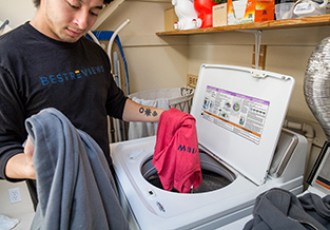BestReviews is reader-supported and may earn an affiliate commission. Details
We recommend these products based on an intensive research process that's designed to cut through the noise and find the top products in this space. Guided by experts, we spend hours looking into the factors that matter, to bring you these selections.

A garbage disposal is a second trash can, one for all the gunk that you don't want sitting in a wastebasket stinking up your kitchen until it's ready to be emptied. It's a cost-effective odor-free device that can help you with even the toughest clean ups. But there are a few things you need to consider before purchasing the one that is best for you.
In general, a continuous feed garbage disposal is a good option because it's always ready to work. However, if you have curious children, a batch feed garbage disposal is a much safer option because it will not function until the lid is securely in place. You want a durable, high-powered model with anti-clogging features and an automatic shutoff.

A garbage disposal is installed under your sink. When you turn it on, the garbage disposal’s blades spin and cut up any food in the sink’s drain into tiny pieces, so the food won’t clog up your plumbing.
There are many ways a garbage disposal can benefit your kitchen.
With a garbage disposal, most leftover food can be put down the drain. As a result, you’ll likely find yourself with less trash.

No more calling a plumber, because a garbage disposal won’t clog your drain.
With a garbage disposal, there is no need to spritz your kitchen with air freshener because of a smelly trash can.

Garbage disposals are low-energy devices, and they help reduce overall food waste.
If you’re not keen on using a compost bin, a garbage disposal is a good alternative.




















The most popular type of garbage disposal, you only need to flip a switch to grind up your leftovers with a continuous feed disposal.
You can also add more food while the disposal is running since it does so continuously.
A septic feed garbage disposal works with a septic system. The device breaks down food waste mechanically, along with the help of microorganisms.
This kind of garbage disposal is basically a food processor for your food waste.
A lid is required for a batch feed disposal, which keeps users safe. The unit will only work with the cover securely tightened.
Newer models are a lot less noisy, but a garbage disposal isn’t going to be your quietest appliance. Higher-end models generally make less noise.
If you notice an unusual sound or buzzing coming from your unit, this could mean something is jammed inside or the device needs maintenance.
Inexpensive garbage disposals are made of less durable materials like aluminum. More expensive units are made of stainless steel and are sturdier and more powerful.
Keep in mind that the cost of a disposal unit does not include installation. In most cases, a garbage disposal should be professionally installed.

Most garbage disposal units will last at least five years. Sturdier, more expensive models can last up to 10 years or longer.
What a garbage disposal is made of is important for its longevity. Stainless steel, for instance, won’t rust as quickly.
The wattage of a garbage disposal’s motor determines how efficiently it can grind food waste.
A high-wattage motor can quickly and powerfully mash nearly any kind of organic matter you put down the drain.
Some garbage disposals have extra features to avoid clogging up the system.
Other models include safety features like auto shutoff.
A few garbage disposals can be hooked up to your dishwasher, so you don’t have to worry about rinsing and scraping off food residue before loading dishes.

Not everything can be put down a garbage disposal. Avoid putting any of the following down your garbage disposal:
Particularly tough vegetables (like celery)
Fruit pits
Oils, fats, grease (these can cause unwanted buildup and clog your system)
Bones
Anything that’s not food

Q. Do I need to get a professional to install my garbage disposal?
A. Probably. A garbage disposal is a powerful device that grinds up food. You don’t want to grind up your fingers, and you’ll want to make sure your garbage disposal is properly installed to prevent leaks.
Q. Should I use hot or cold water when running my garbage disposal?
A. Using cold water reduces the chance of buildup inside the disposal and is more efficient at washing down debris and waste.
Q. How do I clean my new device and keep my fingers?
A. Never stick your hands in a garbage disposal. If you need to take the machine apart to inspect inside, make sure it is powered off, and you’ve cut the electrical supply. Otherwise, some natural ways to clean your disposal are by pouring ice cubes, lemon juice, or vinegar down the drain.
Q. What do I do if my disposal gets jammed?
A. First, troubleshoot a bit. You can stick something down the drain (not your fingers) to try and dislodge whatever may be causing the blockage. You can also try using a wet/dry vacuum to unblock the drain. If these options don’t work, cut the electricity connection to your device before you go inside to try and remove anything that’s stuck. If you still can’t find the culprit, call a professional. Your unit may be damaged.
Get emails you’ll love.
Learn about the products you’re wondering if you should buy and get advice on using your latest purchases.
